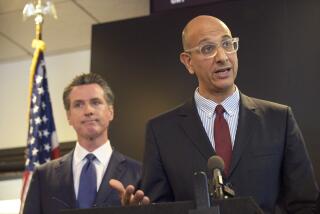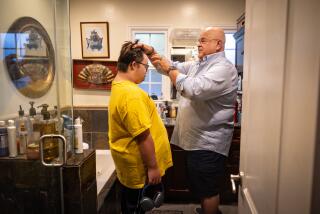State’s Welfare Program Fails, Study Says
- Share via
SACRAMENTO — Gov. Pete Wilson’s highly touted attempt in 1992 to shake people off welfare with carrot-and-stick financial incentives has failed, a two-year study has concluded.
The report by UCLA researchers--obtained by The Times--found little or no change in the behavior of welfare recipients who faced cuts in their cash grants at the same time they were allowed to keep more money from jobs.
Wilson had argued that those changes would help make jobs more appealing than welfare.
Instead, administration officials now concede that the 1992 “Work Pays” program contained faulty assumptions and say it will be scrapped.
“We thought more people would go to work and more people would have higher incomes,” said a senior administration official. “Some things we are talking about don’t work, [so] we are going to change that.”
The report marks the failure of the only Wilson-designed welfare reform to be independently evaluated so far. It is humbling news for the governor just one week before he is scheduled to unveil his plans for a major overhaul of the state’s welfare system.
Wilson has kept his welfare reform plans very close to the vest. But senior administrators said one lesson they will implement from the Work Pays study is to avoid narrow, bureaucratic solutions.
They speculated that the Work Pays program failed in part because recipients did not understand how it worked.
One component of Work Pays allowed recipients to keep the first $30 of their take-home pay and one third of the remaining salary without losing eligibility for any of their welfare benefits.
The explanation of the program in a 1995 state brochure involved an 11-step mathematical formula that a recipient was supposed to use in calculating potential benefits.
Work Pays also ended a previous welfare rule that cut assistance to any household where the primary wage earner worked more than 100 hours per month.
Those two incentives to obtain employment were balanced against a 5.8% cut in welfare grants in 1992 and an additional 2.7% cut in 1993.
“I don’t think the recipients understood the program enough to take advantage of it,” one official said. “You have an eligibility worker trying to explain something very complicated to a recipient who is in crisis. What we learned is that you have to have a program that is much simpler.”
Officials also warned that the failure of the Work Pays program was a reminder of how easy it is for well-intentioned programs to prove ineffective in real-life conditions.
Wilson signed two bills that initiated the Work Pays demonstration project in fall 1992. Months later, he highlighted the idea in his State of the State speech.
“If we hadn’t begun to reform welfare, the system would still penalize those who choose the dignity of a job over the dependency of welfare,” he said. “But we did reform welfare to finally make work pay.”
That year, the program was promoted in an advertising campaign that included brochures, posters and a toll-free number for interested applicants. In 1995, another media blitz for the program added radio and television public service announcements.
“We look forward to significant increases in the number of AFDC clients who are working full or part time,” state social service officials said in a 1995 press kit for the program.
The UCLA study of Work Pays was required by federal authorities who granted California several waivers from previous welfare law to conduct the experiments.
The only other California program to receive federal waivers and an independent evaluation was the state’s Greater Avenues to Independence, or GAIN, work training program. The program got national attention because the report found major success in Riverside County.
Despite that positive review and widespread attention in 1994, GAIN is largely underfunded today. Because of a lack of state funding, fewer than one-quarter of those eligible for the program are now able to participate.
The Work Pays study--expected to be released this week--is nearly 11 months behind schedule. It covers the period between January 1993 and June 1995.
It tracked 15,000 welfare recipients in four counties--Alameda, Los Angeles, San Joaquin and San Bernardino. About 10,000 were subject to the Work Pays program, while 5,000 were separated as a control group and treated under previous rules.
The report found no statistically significant difference in the income, work activity or time on aid between the experimental and control groups in single parent families.
There was some improvement--about 4%--in work activity and income for two-parent welfare families.
In other cases, such as San Bernardino, the group assigned to Work Pays was more likely to remain on assistance longer than the control group.
The report also found that the grant cuts ordered by the state in 1992 and 1993 had little impact on the recipients’ quality of life. Largely, it said they were offset by automatic increases in federal food stamp eligibility and the higher personal savings allowed.
Through extensive interviews with recipients, the report concluded that about 80% of the welfare families were adequate managers of their money.
The report also established a profile of the welfare recipients.
The primary English- or Spanish-speaking household was run by a 33-year-old woman with 10 years of education. The families had an average of 2.6 children and paid about $400 per month in rent.
The findings are important because California faces a major challenge in designing programs to move such recipients into the work force--as federal law now requires.
Even with the promise of an enhanced GAIN program, state officials say they are intimidated by the upcoming task.
“We have never seen anything that has come close to achieving the levels of success that we are going to need,” one official said.
More to Read
Get the L.A. Times Politics newsletter
Deeply reported insights into legislation, politics and policy from Sacramento, Washington and beyond. In your inbox twice per week.
You may occasionally receive promotional content from the Los Angeles Times.










